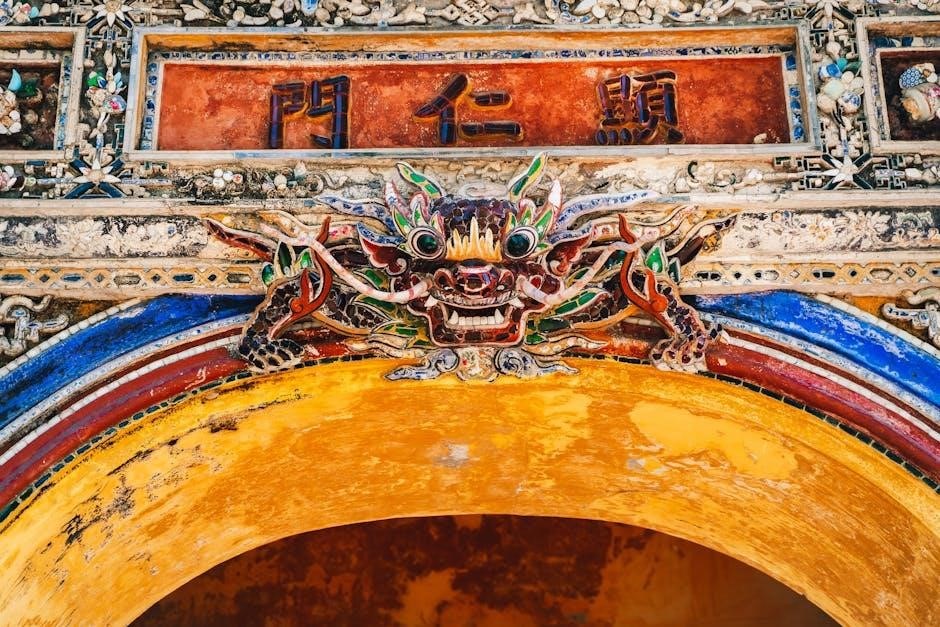The Kinh Dược Sư PDF is a sacred Buddhist text, offering insights into the Medicine Buddha’s teachings, rituals, and historical significance. This document serves as a comprehensive guide for spiritual growth, healing practices, and understanding the Buddhist path. Ideal for both practitioners and scholars, it provides a detailed exploration of the sutra’s core principles and its relevance in modern times.
Overview of the Sutra

The Kinh Dược Sư, or the Medicine Buddha Sutra, is a revered Mahayana Buddhist text that emphasizes the teachings of the Medicine Buddha, Dược Sư Lưu Ly Quang Như Lai. This sutra is known for its profound insights into spiritual healing, compassion, and the eradication of suffering. It outlines the Medicine Buddha’s twelve great vows, which are central to its teachings, and provides guidance on practices for both physical and mental well-being; The sutra is not only a spiritual text but also a practical guide for cultivating mindfulness, ethical conduct, and devotion. Its popularity endures as it offers hope and solace to those seeking relief from afflictions and spiritual growth. The PDF version of the sutra is widely used for study, chanting, and reflection, making it accessible to modern practitioners worldwide.
Importance of the Medicine Buddha
The Medicine Buddha, Dược Sư Lưu Ly Quang Như Lai, holds immense significance in Mahayana Buddhism as a symbol of healing and compassion. His twelve great vows, made as a bodhisattva, pledge to alleviate suffering, cure diseases, and grant spiritual liberation. Devotees believe that invoking his name or chanting the sutra can bring relief from physical and mental afflictions. The Medicine Buddha is often revered for his ability to protect against disasters and negative energies, embodying the Buddhist ideals of loving-kindness and universal salvation. His teachings emphasize the interconnectedness of spiritual and physical well-being, making him a central figure for those seeking both healing and enlightenment. This reverence has endured for centuries, solidifying his role as a source of hope and inspiration for millions of practitioners worldwide.
Structure of the PDF Document
The Kinh Dược Sư PDF is organized into clear sections, making it accessible for both scholarly study and devotional practice. It begins with the core sutra text, detailing the Medicine Buddha’s twelve vows and teachings on healing and compassion. Additional sections include confessional rituals, known as “sám,” which guide practitioners in purifying karma and seeking forgiveness. The document also incorporates supplementary materials, such as historical context, translations, and interpretations by esteemed monks like Thích Trí Quang. References to sources from the Đại tạng and Tục tạng ensure authenticity. The PDF is designed for easy navigation, with sections dedicated to rituals, chanting, and practical applications of the sutra, making it a valuable resource for both spiritual growth and healing practices.

Origin and History of the Medicine Buddha Sutra
The Kinh Dược Sư was first introduced to Vietnam through translations by esteemed monks like Thích Trí Quang, drawing from sources in the Đại tạng and Tục tạng. Its origins trace back to ancient Buddhist scriptures, blending profound philosophy with cultural nuances, making it a cherished text for spiritual seekers today.
The Buddha Dược Sư Lưu Ly Quang Như Lai
Dược Sư Lưu Ly Quang Như Lai, the Medicine Buddha, is revered for his boundless compassion and healing powers. As a Bồ Tát, he made twelve great vows to alleviate suffering and guide beings to enlightenment. His radiant light symbolizes purification and wisdom, while his vows address the physical, mental, and spiritual ailments of sentient beings. This Buddha is often depicted holding a medicine bowl, representing his role as a healer of both body and mind. Worshippers believe that chanting his name and sutra can bring protection, health, and spiritual liberation. His teachings emphasize the interconnectedness of karma, compassion, and healing, making him a central figure in Buddhist rituals and practices.

Historical Background of the Sutra
The Kinh Dược Sư traces its origins to ancient India, where the Medicine Buddha’s teachings were first recorded. The sutra was later translated into Chinese by prominent monks like Xuanzang and Yijing, becoming a cornerstone of East Asian Buddhism. Its popularity grew in China and Japan, where it was integrated into rituals and daily practices. The sutra’s historical journey reflects the adaptation of Buddhist teachings to diverse cultural contexts, ensuring its enduring relevance. Over centuries, it has been a source of spiritual guidance, emphasizing compassion, healing, and the attainment of enlightenment. Its historical significance is evident in its widespread influence on Buddhist traditions and its continued use in modern times for both spiritual and medicinal purposes.
Transmission of the Sutra Across Asia
The Kinh Dược Sư spread widely across Asia, beginning with its origins in India and subsequent translation into Chinese during the Tang Dynasty by monks like Xuanzang and Yijing. From China, it was transmitted to Japan, where it became integral to Buddhist practices, particularly within the Shingon and Pure Land schools. The sutra’s teachings resonated deeply in East Asian cultures, blending with local traditions and becoming a cornerstone of ritual and spiritual life. Its transmission was facilitated by pilgrims, scholars, and missionaries, ensuring its preservation and adaptation across diverse regions. Today, the sutra remains a vital text in temples and homes, guiding followers in their pursuit of healing, enlightenment, and compassion, reflecting its enduring influence on Buddhist thought and practice across Asia.
Modern Interpretations andTranslations
Modern Interpretations and Translations
In contemporary times, the Kinh Dược Sư has been translated into various languages, including English and Vietnamese, by scholars like Thích Trí Quang and Thích Nhật Từ. These translations aim to make the sutra accessible to global audiences while preserving its original spiritual essence. Modern interpretations emphasize its relevance to psychological healing, environmental concerns, and social welfare, appealing to both Buddhist practitioners and non-Buddhists seeking holistic well-being. Digital versions, such as the Kinh Dược Sư PDF, have further facilitated its dissemination, ensuring that the Medicine Buddha’s teachings remain a vital part of modern Buddhist practice and cultural heritage, offering timeless wisdom for personal and collective transformation in an evolving world.

Core Teachings of the Medicine Buddha Sutra
The sutra emphasizes the Medicine Buddha’s Twelve Great Vows, karmic healing through compassion, and practices for spiritual and physical well-being, guiding Buddhists toward enlightenment and harmony.
The Twelve Great Vows of Medicine Buddha
The Twelve Great Vows of Medicine Buddha, as detailed in the sutra, outline his compassionate commitment to relieving suffering. These vows include healing diseases, helping those afflicted by disasters, liberating beings from hellish realms, and guiding the mentally afflicted. Each vow reflects his dedication to eradicating suffering and bringing peace to all beings. By upholding these vows, the Medicine Buddha exemplifies the ideals of compassion, wisdom, and selflessness, inspiring followers to embrace these principles in their own lives. These vows serve as a cornerstone for spiritual practice, offering hope and guidance for those seeking liberation from physical, mental, and emotional afflictions.
Concept of Karmic Healing
The concept of karmic healing in the Medicine Buddha sutra emphasizes the relationship between actions and their consequences on well-being. It teaches that suffering arises from negative karma, which can be purified through spiritual practices. By chanting the sutra and invoking the Medicine Buddha, practitioners believe they can alleviate physical and mental afflictions rooted in past deeds. This healing is not just physical but also spiritual, aiming to cleanse the mind and body of karmic imbalances. The sutra provides rituals and meditations to help followers address their karma and achieve balance, ultimately leading to liberation from suffering. This approach integrates faith, compassion, and self-reflection as essential elements of the healing process.
Practices for Spiritual and Physical Healing
The Medicine Buddha sutra outlines specific practices to achieve spiritual and physical healing. Central to these practices is the chanting of the sutra itself, which is believed to purify the mind and body. Meditation on the Medicine Buddha, visualizing his radiant form, is also a key practice, helping to cultivate compassion and healing energy. Additionally, reciting the Twelve Great Vows and invoking the Buddha’s name through mantras is considered powerful for dispelling suffering. Physical healing practices include the use of sacred sounds and verses from the sutra, which are believed to eliminate afflictions when recited with faith. These practices aim to restore balance and well-being on both spiritual and physical levels, emphasizing the interconnectedness of body and mind in the pursuit of health and enlightenment.
The Role of Compassion in Buddhism
Compassion is a central principle in Buddhism, and the Kinh Dược Sư PDF emphasizes its transformative power. The Medicine Buddha embodies boundless compassion, dedicating his vows to alleviate suffering and bring healing to all beings; Through practices like chanting and meditation, followers cultivate compassion, which is seen as a path to spiritual awakening. The sutra teaches that compassion not only benefits others but also purifies the practitioner’s mind, leading to inner peace and moral integrity. By embracing compassion, individuals can transcend selfishness and embody the universal love exemplified by the Medicine Buddha. This principle is foundational to the sutra’s teachings, inspiring followers to act with kindness and empathy in their daily lives. Compassion, as taught in the Kinh Dược Sư, is a powerful tool for both personal and collective liberation.

Benefits of Studying and Chanting the Sutra
Studying and chanting the Kinh Dược Sư PDF fosters spiritual growth, heals physical and mental suffering, and offers protection from negative energies, cultivating compassion and enlightenment.
Spiritual Growth and Enlightenment
Studying and chanting the Kinh Dược Sư PDF serves as a profound path to spiritual growth and enlightenment. The teachings of the Medicine Buddha guide Buddhists toward the cessation of suffering and the realization of true emptiness. Through devotion and practice, one can purify their karma, cultivate compassion, and attain a deeper understanding of the Buddhist path. Chanting the sutra is believed to bring practitioners closer to enlightenment by fostering mindfulness and concentration. The Medicine Buddha’s vows and wisdom illuminate the journey, offering guidance for overcoming life’s challenges and achieving spiritual liberation. This sacred text thus becomes a powerful tool for those seeking inner peace, wisdom, and ultimate Buddhahood.
Healing of Physical and Mental Suffering
The Kinh Dược Sư PDF is revered for its profound teachings on healing both physical and mental suffering. The Medicine Buddha’s twelve vows emphasize the eradication of diseases and afflictions, offering hope and relief to those in distress. By chanting the sutra and invoking the Medicine Buddha’s name, practitioners believe they can overcome illnesses, dispel mental anguish, and attain peace. The text also highlights the importance of compassion and faith in the healing process, guiding followers to cultivate these qualities. This sacred document serves as a powerful resource for those seeking solace and recovery, providing both spiritual and practical guidance for alleviating suffering and achieving overall well-being.
Protection from Disasters and Negative Energies
The Kinh Dược Sư PDF is deeply revered for its teachings on protecting followers from disasters and negative energies. The Medicine Buddha’s vows promise liberation from suffering, including protection from catastrophes and harmful forces. By chanting the sutra and invoking the Buddha’s name, believers seek divine intervention to ward off misfortunes and cultivate a shield of positive energy. This practice is rooted in the belief that faith and devotion can transform adversity into opportunities for spiritual growth. The text emphasizes compassion as a powerful tool for dispelling negativity, offering both solace and strength to those facing challenges. It thus serves as a spiritual refuge, guiding followers to safety and harmony amidst life’s turmoil.

Practical Applications of the Medicine Buddha Teachings
The teachings emphasize daily practices such as chanting, meditation, and rituals to cultivate compassion and healing. These practices are integrated into both personal and temple ceremonies, fostering spiritual and physical well-being while promoting harmony in daily life.
Daily Practices for Lay Buddhists
Daily practices for lay Buddhists include chanting the Kinh Dược Sư, performing meditation, and reciting the Medicine Buddha’s mantra. These rituals help cultivate compassion and purify the mind. Lay practitioners are encouraged to integrate these practices into their daily routines, even for a few minutes, to foster spiritual growth and well-being. Chanting the sutra is believed to bring blessings, protection, and healing, while meditation enhances mindfulness and inner peace. By adhering to these practices, individuals can align with the teachings of the Medicine Buddha and contribute to a harmonious life. Consistency in these practices is key to experiencing their transformative benefits.
Rituals and Ceremonies in Buddhist Temples
In Buddhist temples, rituals and ceremonies centered on the Kinh Dược Sư often involve communal chanting of the sutra, recitation of mantras, and offerings to the Medicine Buddha. These ceremonies are conducted to seek blessings, healing, and protection for devotees. Monks and laypeople gather to perform these rituals, creating a harmonious and sacred atmosphere. The sutra is chanted to invoke the compassion of the Medicine Buddha, believed to alleviate suffering and bring spiritual purification. These ceremonies are integral to temple life, fostering a sense of community and deepening devotion. They are often performed during special occasions or for individuals seeking relief from illness or adversity, embodying the teachings of the Medicine Buddha and his vow to heal all beings.
The Role of Chanting in Meditation
Chanting plays a vital role in meditation within the context of the Kinh Dược Sư. By reciting the sutra and its associated mantras, practitioners focus their minds and connect with the compassionate energy of the Medicine Buddha. Chanting serves as a powerful tool for cultivating concentration and purifying the mind. It is believed to create a sacred atmosphere, allowing devotees to transcend worldly distractions and immerse themselves in spiritual practice. Regular chanting of the sutra is also seen as a means to invoke blessings, seek protection, and foster inner healing. This practice is deeply rooted in Buddhist tradition and is often recommended for those seeking mental clarity, emotional balance, and a deeper connection to the teachings of the Medicine Buddha.

Cultural and Historical Significance
The Kinh Dược Sư PDF holds deep cultural and historical value, reflecting the transmission of Buddhist teachings across Asia and its enduring influence on spiritual practices and art.
Art and Iconography of Medicine Buddha
The Medicine Buddha, often depicted in vibrant art and iconography, is a central visual element in Buddhist culture. His serene image, typically holding a medicinal bowl, symbolizes healing and compassion. The Kinh Dược Sư PDF highlights how this imagery has evolved across Asia, influencing temple art, sculptures, and paintings. Each representation embodies the Buddha’s vows to alleviate suffering, making him a revered figure in both spiritual and artistic contexts. The fusion of religious devotion and artistic expression underscores the enduring legacy of the Medicine Buddha in Buddhist traditions and daily worship practices.
Festivals and Celebrations Honoring Medicine Buddha
Festivals honoring the Medicine Buddha are vibrant celebrations across Buddhist communities, reflecting deep devotion and cultural richness. These events often coincide with significant Buddhist holidays, featuring elaborate rituals, chanting, and offerings. In many temples, followers adorn statues of the Medicine Buddha with flowers and light, symbolizing purification and healing. The festivals emphasize the Buddha’s vows to alleviate suffering and promote well-being. Participants engage in communal prayers, meditation, and acts of charity, fostering a sense of unity and compassion. These celebrations not only honor the Medicine Buddha but also reinforce his teachings on healing and spiritual growth, making them integral to Buddhist cultural and religious life.
Influence on Traditional Medicine and Healing
The Kinh Dược Sư PDF has profoundly influenced traditional medicine and healing practices, particularly in Buddhist cultures; The sutra emphasizes the interconnectedness of physical and spiritual well-being, inspiring holistic approaches to health. Many traditional healing rituals incorporate chants and prayers from the text, invoking the Medicine Buddha’s blessings for recovery. The sutra’s teachings on compassion, purification, and the elimination of suffering have also shaped the ethical foundations of traditional medicine. In some Buddhist communities, healers and monks use the sutra in rituals aimed at balancing bodily energies and curing ailments. This integration of spirituality and medicine reflects the enduring legacy of the Medicine Buddha’s teachings in promoting health and harmony.

Modern Relevance of the Medicine Buddha Sutra
The Kinh Dược Sư PDF remains highly relevant today, offering teachings on compassion, mental healing, and environmental balance. Its principles inspire modern Buddhist practices, fostering holistic well-being and harmony in contemporary life.
Applications in Contemporary Buddhism
The teachings of the Kinh Dược Sư PDF are widely applied in modern Buddhist practices, emphasizing compassion, healing, and mindfulness. Many Buddhists incorporate the sutra into daily rituals, using chanting and meditation to cultivate spiritual growth. The Medicine Buddha’s vows inspire initiatives for social welfare, environmental conservation, and mental health support. Temples and communities organize retreats and workshops to explore the sutra’s relevance in addressing contemporary challenges. Digital platforms have also made the Kinh Dược Sư PDF accessible globally, enabling followers to study and practice from anywhere. Its universal message of kindness and healing resonates deeply in today’s fast-paced world, making it a vital resource for modern Buddhists seeking balance and harmony.
Psychological and Emotional Healing
The Kinh Dược Sư PDF offers profound teachings for psychological and emotional healing, emphasizing the power of compassion and mindfulness. Chanting the sutra is believed to alleviate mental suffering, reduce stress, and bring inner peace. The Medicine Buddha’s vows provide solace to those facing emotional pain, fostering resilience and hope. Modern practitioners use these teachings to address anxiety, depression, and emotional trauma, finding comfort in the Buddha’s boundless mercy. The sutra’s focus on karma and self-reflection encourages personal growth and emotional balance. Its universal message of healing resonates deeply, making it a vital resource for mental well-being in contemporary life. Through meditation and chanting, followers reconnect with their inner selves, fostering harmony and emotional clarity.
Environmental and Social Implications
The Kinh Dược Sư PDF highlights the importance of harmony between humanity and nature, emphasizing compassion and balance in all aspects of life. The sutra’s teachings encourage followers to adopt sustainable practices and respect the environment, reflecting Buddhist principles of interconnectedness. It also addresses social equity, advocating for the elimination of suffering and the promotion of well-being for all beings. By fostering mindfulness and selfless actions, the Medicine Buddha’s teachings inspire individuals to contribute to societal harmony and environmental preservation. This aligns with contemporary concerns, offering a spiritual foundation for addressing global challenges like climate change and social injustice. Through its timeless wisdom, the sutra encourages a path of sustainability and compassion, benefiting both individuals and the world at large.
The Kinh Dược Sư PDF is a profound guide for spiritual and physical healing, offering timeless wisdom for seekers of peace and well-being. Its teachings remain relevant today, providing a pathway to enlightenment through compassion and mindfulness. This sacred text continues to inspire followers worldwide, serving as a reminder of the Medicine Buddha’s boundless mercy and the power of faith in transforming lives. Through its accessible format, the PDF ensures that ancient Buddhist wisdom is preserved and shared for future generations.

Final Thoughts on the Medicine Buddha Sutra
The Medicine Buddha Sutra, as detailed in the Kinh Dược Sư PDF, embodies a profound synthesis of Buddhist philosophy and healing practices. At its core, the sutra emphasizes the cultivation of compassion and the eradication of suffering through both spiritual and physical means. The Medicine Buddha’s twelve great vows serve as a blueprint for achieving enlightenment and aiding sentient beings. By chanting the sutra and adhering to its teachings, practitioners can attain inner peace, healing, and protection from adversity. This sacred text not only offers solace to those afflicted by illness or misfortune but also provides a pathway to spiritual liberation, making it an indispensable resource for Buddhists and spiritual seekers alike.
Encouragement for Further Study and Practice
Engaging with the Kinh Dược Sư PDF offers a transformative journey into the heart of Buddhist teachings. Readers are encouraged to delve deeper into the sutra’s wisdom, exploring its practical applications in daily life. By embracing the Medicine Buddha’s vows and practices, individuals can cultivate compassion, heal spiritual and physical wounds, and find protection from life’s challenges. Chanting the sutra regularly fosters mindfulness and connection to the Buddhist community. For those seeking enlightenment or solace, this text serves as a timeless guide. We urge all to embrace this sacred resource, integrating its lessons into their spiritual path for profound personal growth and societal benefit.



